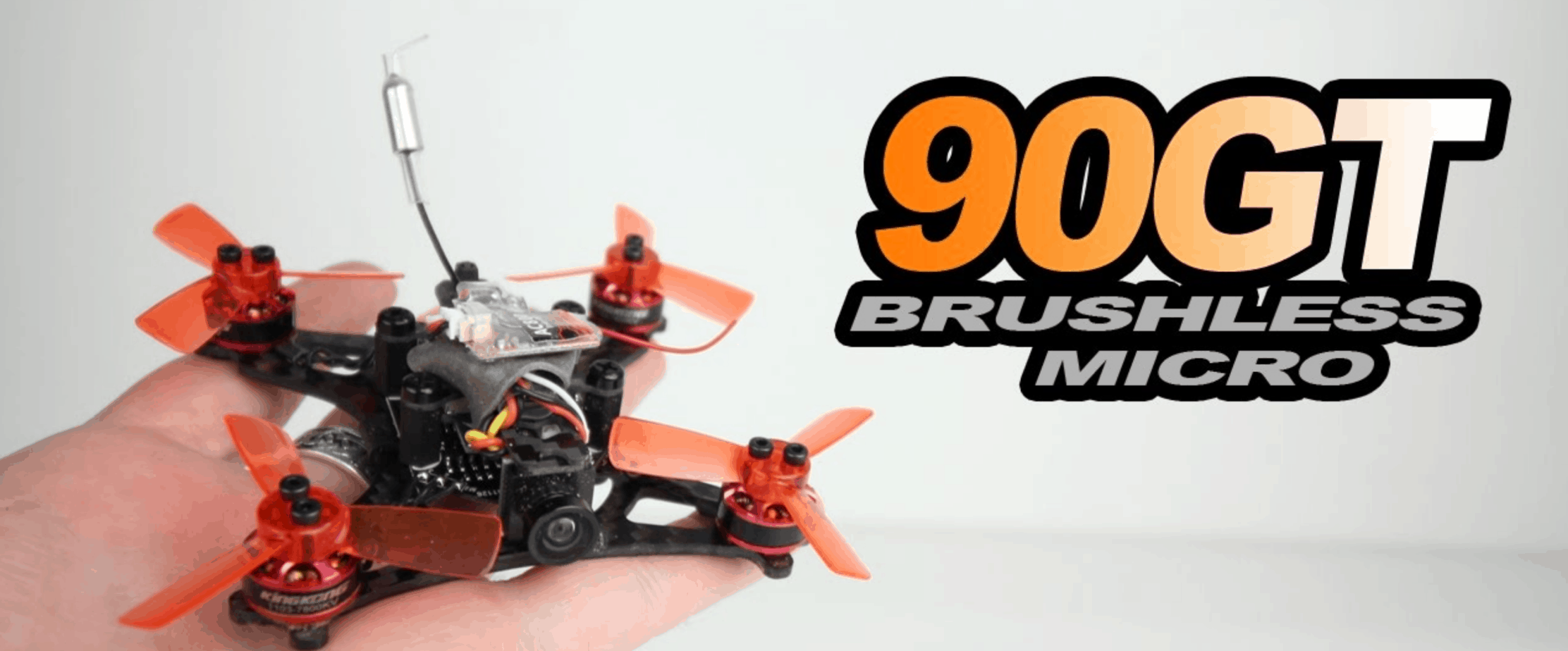KingKong 90GT Review 2020: Small But POWERFUL Little Racing Drone

TranscendFPV is a reader supported product and review site. Clicking on links to learn more, or buy products, may earn us money, and support our work. Learn more about the history of TranscendFPV and our passion on our About page.
KingKong has launched a new KingKong 90GT, which is a far superior microdrone that its predecessor, the Q90.
UAVs are becoming smaller, lighter, and more compact.
Micro and mini drones are quickly becoming a thing thanks to the many advantages they offer compared to the bigger drones. They are way cheaper, spare parts are more affordable, and they don’t fall under too restrictive laws thanks to their low weight.
Roughly about the same size as the previous model, though slightly lighter, the 90GT features a sturdy frame, flexible antenna and plenty of power. Thanks to the brushless motor and tunable flight parameters, the KingKong 90GT leaves the competition in a cloud of dust.
Design and build quality of the KingKong
The first thing you’ll notice is that this KingKong drone is made from high-quality, solid materials.
This drone was built on a stable, 2mm carbon fiber frame; seemingly a lot stronger than the frames delivered on the competitive models. The electronic components are mounted directly on the frame with a set of screws.
The 4-in-1 ESC is mounted on the bottom of the frame with the flight controller sitting on top of it. Both are soldered together by the set of pin headers. This is a bit disappointing because replacing the ESC or flight controller requires doing some heavy soldering work.
- The 4-in-1 ESC contains a voltage regulator which provides power to the FC which sits directly above it. It also provides power to the video transmitter and an FPV camera.
- The second 2mm carbon fiber plate is secured on top of the flight controller with four screws, with an FPV camera superglued to this plate.
- The camera sits in a fixed, “straight forward” position, with the lens extending out from the frame by quite a bit. This makes the camera lens vulnerable to scratches and other damage during crashes.
- A 16-channel 25mW video transmitter sits at the top of the second, upper plate. A linear dipole antenna, which is attached to the video transmitter, is mounted to the back of the frame.
- The propellers included with the drone are quite good, but they’re too brittle. Crashing a drone will surely break them, so consider buying an alternative, more durable replacement props.
Still, the propellers are screwed onto the motors with two screws each. Other than being rigid, they’re quite efficient.
The battery is mounted on the bottom side of the frame, next to the radio transmitter. It offers up to 5 minutes of flight indoor, and 2-3 minutes of outdoor flight.
However, this little quadcopter can easily carry a more massive battery, so you might want to upgrade to a 500mA battery for more power and extended flight time.
Instead of conventional, brushed motors, the KingKong 90GT features brushless motors. These are more powerful and more durable than conventional motors, with a long-lasting lifespan, since they virtually have no wear factors. In other words, you’ll practically never have to replace them.
The overall build quality is quite sturdy and feels nicely done. There are no flexing or flopping parts, and everything seems fitted tight into place.
FPV Camera specs
The KingKong is equipped with a 600TVL 16-channel 25mW camera, which unfortunately offers mediocre performance.
The image it provides is good; however, as with most low-budget FPV cameras, it doesn’t handle changes in lighting very well.
As with most micro drones, the camera is mounted in a “straight forward” position, offering a 120° field of view. This position may be suitable for indoor flying, but it’s not ideal for performing aerial acrobatics or racing outdoor.
You can fix this with a little bit of hot glue, and a 20° drop can significantly improve your FOV during aerial acrobatics.
The video transmitter offers 16 channels, meaning you get four channels for each frequency band, with a differently colored LED marking each frequency. Pressing the small button on the video transmitter changes the transmitting video channel, thus changing the LED color.
600TVL might be the only downside of this micro drone since its performance is lacking. It might be challenging to change the cam because the propellers limit the space on the drone. However, 1000TVL offers better performance, and it proves to be a good replacement cam.
Receiver
The 90GT comes with a DSM2 receiver, sporting two antennas to improve reception quality. When connected via the DSM2, the receiver can offer up to seven channels.
This number can be pushed to eight by connecting the receiver to DSMX, but it’s not recommended that you do so. Though it offers eight channels, it doesn’t perform as well as DSM2.
Flight performance
Even with the standard PIDs, the KingKong 90GT flying performance is excellent. It’s incredibly stable, although it’s very agile as well. Of course, its power cannot compare to that of more prominent 4S racers.
Please, do take the time to adjust some settings in BetaFlight as this may seriously improve performance. Still, even with the default setting, this micro drone offers enough power for some serious aerial acrobatics and racing.
Flying outdoor is where this drone is at its best as it offers excellent outdoor performance. Just keep your and other people’s safety in mind, and use the included prop guards. Installing these isn’t hard, and the included manual offers a detailed description of how to do it.
Pros and cons
This micro drone proves to be a fantastic entry-level aircraft for drone racers, and with its carbon fiber frame, it offers serious build quality.
The use of long-lasting brushless motors provides more power and less wear, meaning you won’t have to change them. Other than physical damage, these motors are indestructible.
- The KingKong 90GT is ready to fly straight from the box. However, do spend some time adjusting the settings, as it may significantly improve flight performance.
- Keep in mind that, as with many FPV quads, the camera might be misaligned or not correctly focused. This particular problem is easily fixable, so it shouldn’t be much of a hassle.
On the downside, this drone has no low voltage buzzer or alarm, so you should keep track of your flight time. Also, 600TVL camera (comes with the drone) might not offer proper performance, so you might want to switch it for 1000TVL.
Other than that, this is a great little FPV quadcopter, which guarantees excellent performance and fun.
You can read more reviews here and learn more about it.

